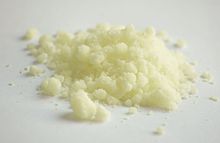2,4-dinitrochlorobenzene
| Structural formula | ||||||||||||||||||||||
|---|---|---|---|---|---|---|---|---|---|---|---|---|---|---|---|---|---|---|---|---|---|---|

|
||||||||||||||||||||||
| General | ||||||||||||||||||||||
| Surname | 2,4-dinitrochlorobenzene | |||||||||||||||||||||
| other names |
|
|||||||||||||||||||||
| Molecular formula | C 6 H 3 ClN 2 O 4 | |||||||||||||||||||||
| Brief description |
yellow crystalline solid with a characteristic odor |
|||||||||||||||||||||
| External identifiers / databases | ||||||||||||||||||||||
|
||||||||||||||||||||||
| properties | ||||||||||||||||||||||
| Molar mass | 202.55 g mol −1 | |||||||||||||||||||||
| Physical state |
firmly |
|||||||||||||||||||||
| density |
1.68 g cm −3 (20 ° C) |
|||||||||||||||||||||
| Melting point |
53 ° C |
|||||||||||||||||||||
| boiling point |
315 ° C |
|||||||||||||||||||||
| solubility |
Practically insoluble in water (8 mg l −1 at 15 ° C) |
|||||||||||||||||||||
| Refractive index |
1.5857 (60 ° C) |
|||||||||||||||||||||
| safety instructions | ||||||||||||||||||||||
|
||||||||||||||||||||||
| Toxicological data | ||||||||||||||||||||||
| As far as possible and customary, SI units are used. Unless otherwise noted, the data given apply to standard conditions . Refractive index: Na-D line , 20 ° C | ||||||||||||||||||||||
2,4-Dinitrochlorobenzene ( 1-chloro-2,4-dinitrobenzene ) is an organic compound consisting of a benzene ring with a chlorine (–Cl) and two nitro groups (–NO 2 ) as substituents . It belongs to the group of dinitrochlorobenzenes , in which six constitutional isomers result from the different arrangement of the substituents .
Extraction and presentation
2,4-Dinitrochlorobenzene can be obtained from 2,4-Dinitrophenyl sulfide by chlorination . The synthesis starting from chlorobenzene and its nitration is also known and has already been described by Fritz Ullman in the practical book.
properties
2,4-Dinitrochlorobenzene is a yellow crystalline solid with a characteristic odor, which is practically insoluble in water. It comes in three forms, with only the alpha form being stable. The compound forms inflammable vapor-air mixtures at high temperatures. The compound has a flash point of 194 ° C. The explosion range is between 1.9% by volume (160 g / m 3 ) as the lower explosion limit (LEL) and 22% by volume (1850 g / m 3 ) as the upper explosion limit (UEL). The compound decomposes when heated, which can produce chlorine, hydrogen chloride , phosgene , carbon dioxide and carbon monoxide .
use
2,4-Dinitrochlorobenzene is used as a reagent for alkylation , arylation and substitution reactions and for the production of dyes , photochemicals, explosives , fungicides and rubber chemicals.
To prepare 1-fluoro-2,4-dinitrobenzene (Sanger's reagent), 1-chloro-2,4-dinitrobenzene is reacted in nitrobenzene with potassium fluoride (KF).
safety instructions
2,4-Dinitrochlorobenzene can detonate like explosives when ignited, especially when confined. The compound is a very strong contact allergen .
literature
- Friedrich Konrad Beilstein, Bernhard Prager, Paul Jacobsen: Beilstein's manual of organic chemistry. Comprehensive literature by January 1, 1910 . Ed .: German Chemical Society. 4th edition. tape 5 : cyclic hydrocarbons . Springer, Berlin 1922, OCLC 643750406 , p. 263 ( archive.org ).
- Friedrich Konrad Beilstein, Friedrich Richter: Beilstein's handbook of organic chemistry . As a supplement d. 5th band d. Hauptwerkes, the literature from 1920-1929 comprehensive. Ed .: German Chemical Society. 4th edition. tape 5 , supplementary work 2. Springer, Berlin / Heidelberg 1943, OCLC 630323514 , p. 196 ( archive.org ).
Individual evidence
- ↑ a b c d e f g h i j k l m n Entry on 1-chloro-2,4-dinitrobenzene in the GESTIS substance database of the IFA , accessed on June 24, 2017(JavaScript required) .
- ↑ David R. Lide (Ed.): CRC Handbook of Chemistry and Physics . 90th edition. (Internet version: 2010), CRC Press / Taylor and Francis, Boca Raton, FL, Physical Constants of Organic Compounds, pp. 3-100.
- ↑ Small synthesis corner. Technical University of Ilmenau, accessed on May 1, 2020 (German).
- ^ E. Brandes, W. Möller: Safety-related parameters - Volume 1: Flammable liquids and gases. Wirtschaftsverlag NW - Verlag für neue Wissenschaft GmbH, Bremerhaven 2003.
- ^ Hans Billroth Gottlieb: The Replacement of Chlorine by Fluorine in Organic Compounds . In: Journal of the American Chemical Society . tape 58 , no. 3 , March 1936, p. 532-533 , doi : 10.1021 / ja01294a502 .
- ^ HG Cook, BC Saunders: 1: 2: 4-Fluorodinitrobenzene . In: Biochemical Journal . tape 41 , no. January 4 , 1947, p. 558-559 , PMID 20270792 , PMC 1258537 (free full text).
- ↑ NS Wedroff: On the question of skin sensitization. Raising awareness of dinitrochlorobenzene under commercial conditions . In: Archive for industrial pathology and industrial hygiene . tape 3 , no. 4 , 1932, pp. 509-522 , doi : 10.1007 / BF02125115 .





